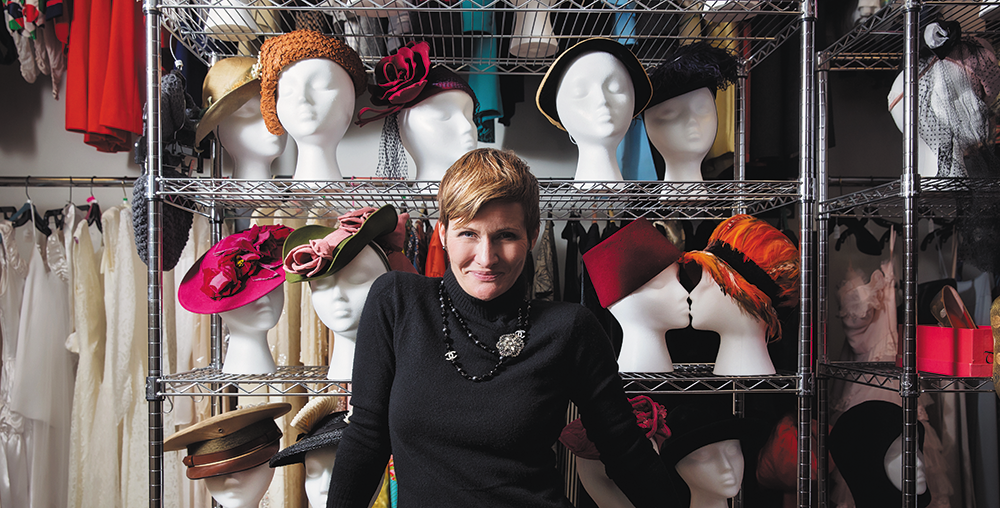Jeanne Lanvin. Edie Sedgwick. Gloria Vanderbilt. Elsa Shiaparelli. Valentina. Mary Quant. Coco Chanel. They weren’t just It Girls—they were women whose obsession with fashion shaped and inspired generations to come. Say what you will about addiction, it isn’t always a bad thing.
Claudine Villardito, owner of Black Cat Vintage and Mrs. Robinson’s Affairs, can’t hide and certainly doesn’t apologize for her addiction to relics from times past. “I have a problem with old things,” Villardito says. “It’s a surprise I’m not having an affair with an 80-year-old man!”
Villardito has been collecting vintage clothing (mostly women’s wear, but select men’s items, too) for more than 20 years. Formerly based in Tucson, she took over the Black Cat Vintage business in 2005. With her new space in downtown Phoenix and her online business launched, she now devotes 100 percent of her time to vintage restoration and sales.
Sometimes she’s replacing a button or zipper and sometimes she is sewing on fine beading.
Villardito grew up in Tucson and was constantly inspired by her entrepreneurial mother, Gale Maly, who she says is her hero. Maly and Associates has been a wildly successful property management and real estate company for decades. Maly began as an entrepreneur in Chicago. She ran a photography business that she took over from her father after his death, in order to keep the family afloat. At 21 years old, Maly found herself a divorcee and single mother. She decided to move to Tucson and start over.
“I started collecting very, very humbly, with very little money,” Villardito says. Somehow special vintage objects just seemed to find her. “Because I’m such a sucker, I usually take all of it,” she says of the estate sales and lots of women’s clothing she used to come across.
Over time, she amassed such a collection that she filled up all of the closets of the 1939 home she shared with her husband. “But back then, people didn’t need big closets. The clothes were so well made and they were meant to last, you didn’t have as many,” she says.
She hunts down the original owners of items and collects many pieces of ephemera: receipts, letters, photographs and magazine clippings to confirm the provenance for each.
Villardito got to the point where she simply could not stop collecting. At some point she ran out of space and had to make a new rule: get rid of some before you acquire more. At first it was difficult. “I was like: I can’t see my babies!” she says. But she made a mission of it—to find the right people to acquire her precious treasures, and that’s how her business was born.
Villardito believes that quality vintage clothing is a finite resource—something that can’t be replaced. “These pieces are just as valid as any form of art—as a painting, a piece of music or a work of architecture.” That is what makes her restoration work a true mission.
When Villardito gets in the zone on a restoration project, she could spend days, weeks or even months to bring a garment back to its original glory. She holds out her hands and explains that sometimes her fingers get swollen because of the delicacy of the work. Sometimes she’s replacing a button or zipper and sometimes she is sewing on fine beading. Some pieces are not restorable, so she mines them for parts, kind of like an auto yard where you might find a replacement fender or spare hubcap.
“I’m like a Native American; I use everything and throw nothing away,” she says. Villardito describes saving zippers, hooks, eyes and snaps—all the way down to the very thread a garment was sewn with. She makes it a point not to alter the garments in any way and avoids adding her own artistry or personal touches. What this means is that each of her restored pieces rings with authenticity.
She holds up a 1920s beaded silk flapper dress, which had been hanging in the vault with her best-quality garments. This item had been stored in an oily box for years. Unfortunately, the oil seeped into the skirt of the garment, rending it unsalvageable. But Villardito was able to match the vintage fabric, gently take the garment apart, and bring in her master seamstress, Debbie Ryan from Tucson, to cut a new skirt. Then Villardito went to work beading—sewing the literally hundreds of beads back onto the blouse. The result is a stunning restoration, indeed.
“Restoration is hand and eye work, and everything I do requires my hands to be in water, dye, steam, freezing temperatures (for decontamination) or cleaning solutions. These are the conditions that turn my hands into baseball mitts by the end of a project.” She has unfortunately started to experience some arthritis in her hands and has noticed changes in her eyesight.
Ironically, it was during a period of physical recuperation that Villardito got into restoration in the first place. In the early 2000s, she was going to college for a degree in international business. But after few years, she determined that this was not her passion. She then decided, since she loved animals so deeply, to study veterinary medicine. Villardito says she enjoys research and learning (she speaks five languages), and science has never been too difficult for her, so she figured she would fare well in the coursework required to obtain a degree in animal medicine.
But the universe seemed to have other plans for Villardito. In 2004, only about one year into her veterinary studies, she was involved in a serious car accident with a drunk driver and essentially ended up in a body cast. Her right wrist was crushed. It took six surgeries to repair her wrist and other bodily injuries, and she was bedridden for 18 months.
Fueled by an inexhaustible inner energy, Villardito was frustrated by the fact that she couldn’t get up and get things done. “One day my husband came home and found me vacuuming [in my body cast],” she says. Immediately he and her physician ordered her back to bed. Villardito asked her husband to bring her some of her vintage items that needed repair, and finally she was able to occupy her mind with something useful.
Though Villardito had done some studies in fashion, she had not learned restoration, nor had she much experience in sewing (although she had previously taught herself how to knit and do beading). From her bedroom-turned-studio, she delicately deconstructed and reassembled items, made repairs and did research. She taught herself how to professionally tailor and repair vintage items, and the process was fairly rehabilitative for her wrist, she says.
In Villardito’s collection are items decommissioned from art houses and major museums. She has obtained pieces that were once in the collections of FIT, FIDM and the Metropolitan Museum of Art. Some of the garments have even appeared in films, such as a dress from My Week with Marilyn, she says.
She hunts down the original owners of items and collects many pieces of ephemera: receipts, letters, photographs and magazine clippings to confirm the provenance for each. Her goal, she says, is to build proper archival records to fulfill National Archives standards. She also records oral histories whenever possible for those items that come with a story.
There are only three pieces in Villardito’s collection that are too delicate to be worn, and one is a corset from the 1700s. “Twenty years ago when I started collecting, I had this nightmare that there was an item out there, some important item from history, that was just being thrown away.”
One day she received a call from a friend in Las Vegas—something incredible was happening, almost like the culmination of that nightmare. A serious clothing collector had died and her husband had rented a dumpster and a backhoe and was throwing it all away. The woman’s name was Irene Dunne. She and her husband had been like Las Vegas royalty. Villardito says, “They entertained the entertainers in their palatial home.” Villardito contacted Dunne’s husband and told him: “If you’re just going to throw it out, I’ll take it. I will take it all!”
She struck a deal with Dunne’s husband. A week later, three massive trucks arrived at her home in Tucson. It took months to go through everything, Villardito says. “She had a taste for the same things I do,” Villardito says. And this is where she happened upon the corset.
Villardito knew right away it was something very old and possibly of great value. But it had no provenance. So she began researching in the archives of the Metropolitan Museum of Art, and then moved on to those of the Société des Arts Decoratifs. Finally she was able to match the style of the corset to those of the 1700s—something akin to Marie Antoinette’s undergarments.
Black Cat Vintage is constantly being contacted by people who want to send in their vintage items. But because of the crunch for storage space, Villardito is highly selective. “A lot of people have vintage, but not all of it is museum-worthy or archival quality.” All of the most priceless “watershed” pieces in Villardito’s collection are part of the Black Cat Vintage collection.
Villardito has also assembled a collection of more price point-friendly daily wear called Mrs. Robinson’s Affairs. These items may not have designer labels, but they are certainly the fanciful and elaborate dress clothes of everyday women from the 1930s, ’40s and ’50s. Women would get dressed with many accessories to do regular tasks, she explains, even housework, gardening, laundry and shopping for groceries. Back then, one did not leave the house without gloves, a hat, jewelry and matching handbag.
Villardito has also assembled a collection of more price point-friendly daily wear called Mrs. Robinson’s Affairs.
Villardito’s love of all things retro guided her to her current spot in downtown Phoenix. The historic mid-century Monroe Building (111 W. Monroe) was built in 1969. She moved her business in April 2015. Her husband, Andrew Papanikolas, runs a high-end audio retail store out of the space facing Monroe Street. Black Cat Vintage maintains a well-designed window (Monroe and First Avenue) that Villardito plans to change seasonally. Her business is not a walk-in style shop, but rather mostly conducts business online and occasionally by appointment.
Villardito says she is energized by the sort of renaissance downtown Phoenix is experiencing, and she is quite glad to be situated where she is. “I’m so proud of what is happening downtown,” she says. “It is reassuring and moralizing to see young people taking the higher road.”
Villardito will be a featured lecturer at a presentation by Arizona Costume Institute at Phoenix Art Museum, May 11. She is presenting on fashion preservation, conservation and the history of vintage.


